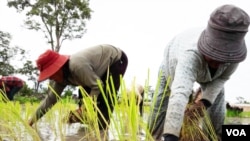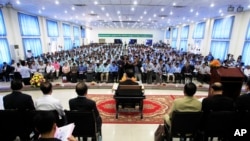In the early 1990s, as the United Nations was struggling to broker a peace deal in Cambodia following decades of genocide and civil war, neighboring Vietnam was striding away from its own violent past thanks to a wave of reforms that would establish the socialist state as a regional economic power.
While Cambodia has enjoyed strong growth and an influx of foreign investment in recent years, a toxic combination of rising wages and low-skilled labor presents a looming threat to the country’s two-dimensional economy.
The solution, experts say, may lie in Vietnam’s example.
Still reeling from the Vietnam War and facing an unprecedented economic crisis, Hanoi in 1986 instituted the Doi Moi Policy, a series of top-down reforms aimed at gradually liberalizing the economy. The country was soon reaping rewards of free-market capitalism: robust trade, steady foreign investment and a flowering of private businesses.
With growth projected to remain well above 6 percent in the coming years, Vietnam has positioned itself as a crucial manufacturing hub for big-brand electronics, home appliances, and mobile phones. Samsung products alone comprised a quarter of the country’s $227 billion in exports last year, the South China Morning Post reported recently.
According to the Washington-based Brookings Institution, Vietnam added 1.5 million new manufacturing jobs between 2014 and 2016.
State-sponsored vocational training, a productive workforce and low operating costs continue to lure overseas investors seeking both skilled and unskilled labor. And with a population soon to top 100 million, Vietnam’s growing workforce has helped fill the vacuum left by China’s shrinking one.
Although Cambodia is also experiencing strong growth — the World Bank expects 6.9 percent in 2018 — the economy is reliant on two industries — agriculture and textiles — with tourism, gambling and light manufacturing playing comparatively minor roles.
Rice dominates the agricultural sector, trailed by crops including rubber, cassava, soybeans, and sweet potatoes. The garment industry, which employs one in four working Cambodians and more than 85 percent of all factory workers, accounts for roughly half of the country’s total exports, though this share is declining.
Between 2000 and 2008, exports of garments and footwear comprised 75.6 percent of the country’s total, compared to 58 percent during the period from 2009 to 2013, according to the government’s 2015-2025 Industrial Development Policy (IDP).
The IDP acknowledges a “weak and narrow” industrial sector marked by a “lack of diversity,” “weak entrepreneurship” and “low level of technology.” The goal, according to the IDP, is “to transform and modernize Cambodia’s industrial structure from a labor-intensive industry to a skill-driven industry” by 2025.
“I do not think that Cambodia will reduce its dependence on garment manufacturing as fast as the IDP envisages,” Miguel Chanco, Senior Asia Economist at the UK-based Pantheon Macroeconomics, told VOA Khmer in an email interview.
Chanco notes that recent wage hikes in the garment industry are undermining efforts to reduce the economy’s dependence on the sector. In 2012, factory workers took home a government-mandated minimum of $61 per month. Today, they are guaranteed at least $170 – a threefold increase in six years.
Prime Minister Hun Sen, whose Cambodian People’s Party won this year’s national election after eliminating any real challengers, makes regular appearances at garment factories and recently suggested that the minimum wage could exceed $250 by 2023.
Transitioning from a textile-dominated industry to one buttressed by electronics and other light manufacturing would help Cambodia compete with economic rivals such as Bangladesh, Myanmar, and Vietnam, Chanco says, but those countries already benefit from the triple threat of low wages, high productivity, and a large workforce.
Cambodia has “abundant low-skilled labor, but it is expensive relative to our competitors,” says Sophal Ear, an associate professor of diplomacy and world affairs at Occidental College in Los Angeles.
“Populism through higher minimum wages has created an economic trap for Cambodia because we are less competitive,” Ear says. “But it could be that wages will be stuck for five years and Cambodia will slowly regain its competitive advantage.”
Ky Sereyvath, an economic researcher based in Phnom Penh, is not holding his breath.
“I do not think that Cambodia is ready to transform into a manufacturer of light electronics yet because our labor skills and productivity are rather limited,” he says. “We lack both the creativity and vocational schools to boost this industry.”
Through his field research, Sereyvath found that teachers in rural areas are woefully unqualified, while many high school graduates lack a basic understanding of math and physics.
Government-run vocational training opportunities for dropouts and undereducated graduates would go a long way toward addressing these inadequacies, Sereyvath believes.
“In order to achieve the IDP 2025, the government needs to reform the whole educational system to ensure quality…and to make sure that students are happy to go to school,” he says.
“The bottom line is that countries cannot compete for long on low skills and cheap labor,” agrees Ear. “You have to upgrade your skills.”
But wages and skills are only part of the problem, experts say. Other roadblocks to economic reform include high power prices, poor infrastructure, and corruption.
“There are three issues that Cambodia needs to solve,’’ said Ou Virak, founder of the Future Forum in Phnom Penh. ‘’One: We need to make electricity cheaper and more efficient. Two: We need good roads, ports and logistics services. Three: We need rule of law and a court system that protects businessmen.”
Manufacturers in Cambodia pay nearly 20 cents per kilowatt-hour of electricity, compared to about 7 cents in Vietnam.
When it comes to infrastructure, the disparity is arguably starker. In its most recent Logistics Performance Index, the World Bank ranked Cambodia 98 out of 160 countries surveyed. Vietnam, by contrast, was ranked 39, close behind Thailand (32) and beating out regional rivals such as Malaysia (41), Indonesia (46) and the Philippines (60).
And compared to efforts to modernize and diversify the economy, Ear says, “there isn’t nearly as much progress on poor governance and corruption.”
“If anything, it seems we are stuck in a bad governance trap. Monopoly interests, gatekeepers everywhere… this is not good for businesses who want to compete,” Ear says. “It is a race to the bottom.”
Again, Vietnam potentially holds the clue, says Chanco of Pantheon Macroeconomics.
“I think Cambodia would do well to follow Vietnam’s example in striking ambitious free-trade deals with key partners,” he says. “That won’t be the end-all and be–all, though, because Cambodia is well behind in terms of developing its human capital and closing its infrastructure gaps. Both factors will continue to hinder Cambodia’s move up the value chain.”
“The main difference for me is a focus,” Chanco adds. “Whereas the government in Cambodia is more preoccupied with establishing its hold on political power — sometimes at the expense of much-needed structural economic reforms — policymakers in Vietnam are much more focused on economic advancement.”












